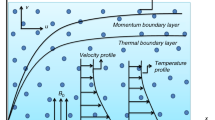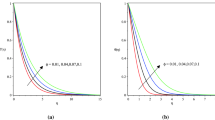Abstract
On the basis of symmetry group analysis applied to fluid flow, heat and mass transfer equations for nanofluids in parabolic approximation, their symmetries (i.e., the Lie groups) were obtained. Using these groups, self-similar forms for independent variables and functions were derived, which describe velocity, temperature and concentration fields. These forms enabled obtaining generalized self-similar ordinary differential equations for parabolic flows of nanofluids. In these equations, physical properties of nanofluids (viscosity, thermal conductivity, diffusion coefficients and density) were specified in general form as functions of the temperature and nanoparticle concentration. Therefore, the proposed equations by their nature are universal and free from any specific form of the functional dependence of the physical properties of nanofluids on the temperature and nanoparticle concentration. Self-similar equations take into account different additional effects that arise in nanofluid flows. The paper includes particular examples of the description of specific problems (flows with streamwise pressure gradient, impingement, turbulence, free convection, boiling, etc.) on the basis of generalized transport equations. A novel self-similar solution for heat transfer in nanofluids accounting for dissipation effects was derived in the paper. This solution demonstrates that adding of nanoparticles causes earlier conversion of the cooling mode into the heating mode.







Similar content being viewed by others
References
Maxwell JC. Treatise on electricity and magnetism. London: Oxford University Press; 1904.
Keblinski P, Phillpot SR, Choi SUS, Eastman JA. Mechanisms of heat flow in suspensions of nano-sized particles (nanofluids). Int J Heat Mass Transf. 2002;45:855–63.
Yu W, France DM, Routbort JL, Choi SUS. Review and comparison of nanofluid thermal conductivity and heat transfer enhancements. Heat Transf Eng. 2008;29(5):432–60.
Brinkmann HC. The viscosity of concentrated suspensions and solution. J Chem Phys. 1952;20:571–81.
Maiga SEB, Palm SM, Nguyen CT, Roy G, Galanis N. Heat transfer enhancement by using nanofluids in forced convection flows. Int J Heat Fluid Flow. 2005;26:530–46.
Abu-Nada E, Masoud Z, Oztop HF, Campo A. Effect of nanofluid variable properties on natural convection in enclosures. Int J Therm Sci. 2010;49:479–91.
Ho CJ, Chen MW, Li ZW. Numerical simulation of natural convection of nanofluid in a square enclosure: effects due to uncertainties of viscosity and thermal conductivity. Int J Heat Mass Transf. 2008;51:4506–16.
Ghasemi B, Aminossadati SM. Periodic natural convection in a nanofluid-filled enclosure with oscillating heat flux. Int J Therm Sci. 2010;49:1–9.
Ogut EB. Natural convection of water-based nanofluids in an inclined enclosure with a heat source. Int J Therm Sci. 2009;48:2063–73.
Thang BH, Khoi PH, Minh PN. A modified model for thermal conductivity of carbon nanotube-nanofluids. Phys Fluids. 2015;27:032002.
Nold A, Oberlack M. Symmetry analysis in linear hydrodynamic stability theory: classical and new modes in linear shear. Phys Fluids. 2013;25:104101.
Avramenko AA, Kobzar SG, Shevchuk IV, Kuznetsov AV, Iwanisov LT. Symmetry of turbulent boundary-layer flows: investigation of different eddy viscosity models. Acta Mech. 2001;151(1–2):1–14.
Avramenko AA, Blinov DG, Shevchuk IV. Self-similar analysis of fluid flow and heat-mass transfer of nanofluids in boundary layer. Phys Fluids. 2011;23:082002.
Avramenko AA, Blinov DG, Shevchuk IV, Kuznetsov AV. Symmetry analysis and self-similar forms of fluid flow and heat-mass transfer in turbulent boundary layer flow of a nanofluid. Phys Fluids. 2012;24:092003.
Avramenko AA, Shevchuk IV, Abdallah S, Blinov DG, Harmand S, Tyrinov AI. Symmetry analysis for film boiling of nanofluids on a vertical plate using a nonlinear approach. J Mol Liq. 2016;223:156–64.
Avramenko AA, Shevchuk IV, Abdallah S, Blinov DG, Tyrinov AI. Self-similar analysis of fluid flow, heat, and mass transfer at orthogonal nanofluid impingement onto a flat surface. Phys Fluids. 2017;29:052005.
Buongiorno J. Convective transport in nanofluids. ASME J Heat Transf. 2006;128:240–50.
Kuznetsov AV, Nield DA. Natural convective boundary-layer flow of a nanofluid past a vertical plate. Int J Therm Sci. 2010;49:243–7.
Yacob NA, Ishak A, Pop I, Vajravelu K. Boundary layer flow past a stretching/shrinking surface beneath an external uniform shear flow with a convective surface boundary condition in a nanofluid. Nanoscale Res Lett. 2011;6(314):1–7.
Mahdavi M, Sharifpur M, Meyer JP. A novel combined model of discrete and mixture phases for nanoparticles in convective turbulent flow. Phys Fluids. 2017;29:082005.
Azhar WA, Vieru D, Fetecau C. Free convection flow of some fractional nanofluids over a moving vertical plate with uniform heat flux and heat source. Phys Fluids. 2017;29:082001.
Schlichting H, Gersten K. Boundary layer theory. 8th ed. Berlin: Springer; 2000.
Loitsyanskii LG. Mechanics of liquids and gases. Oxford: Pergamon; 1966.
Olver P. Applications of Lie groups to differential equations. New York: Springer; 1985.
Blasius H. Grenzschichten in Flüssigkeiten mit kleiner Reibung. Z Angew Math Phys. 1908;56:1–37.
Pohlhausen E. Der Wärmeaustausch zwischen festen Körpern und Flüssigkeiten mit kleiner reibung und kleiner Wärmeleitung. ZAMM. 1921;1(2):115–21.
Wen D, Ding Y. Experimental Investigation into convective heat transfer of nanofluids at the entrance region under laminar flow conditions. Int J Heat Mass Transf. 2004;47:5181–8.
Pak BC, Cho YI. Hydrodynamic and heat transfer study of dispersed fluids with submicron metallic oxide particles. Exp Heat Transf. 1998;11:151–70.
Magyari E, Weidman PD. Heat transfer on a plate beneath an external uniform shear flow. Int J Therm Sci. 2006;45:110–5.
Makinde OD, Khan WA, Khan ZH. Buoyancy effects on MHD stagnation point flow and heat transfer of a nanofluid past a convectively heated stretching/shrinking sheet. Int J Heat Mass Transf. 2013;62:526–33.
Avramenko AA, Shevchuk IV, Tyrinov AI, Blinov DG. Heat transfer in stable film boiling of a nanofluid over a vertical surface. Int J Therm Sci. 2015;92:106–18.
Bromley LA. Heat transfer in stable film boiling. Chem Eng Prog. 1950;46:211–27.
Ellion ME. A study of the mechanism of boiling heat transfer. Jet Prop Lab Memo CIT. 1954;20:1–88.
Yang XF, Liu ZH. Pool boiling heat transfer of functionalized nanofluid under sub-atmospheric pressures. Int J Therm Sci. 2011;50:2402–12.
Falkner VM, Skan SW. Some approximate solutions of the boundary layer equations. Philos Mag. 1931;12:865–96.
Temah MA, Dawood MMK, Shehata A. Numerical and experimental investigation of flow structure and behaviour of nanofluids flow impingement on horizontal flat plate. Exp Therm Fluid Sci. 2016;74:235–46.
Zeiton O, Ali M. Nanofluid impingement get heat transfer. Nanoscale Res Lett. 2012;7:139–47.
Glauert MB. The wall jet. J Fluid Mech. 1956;1(6):625–43.
Wenhua Y, France DM, Routbort JL, Choi SUS. Review and comparison of nanofluid thermal conductivity and heat transfer enhancements. Heat Transf Eng. 2008;29(5):432–60.
Author information
Authors and Affiliations
Corresponding author
Rights and permissions
About this article
Cite this article
Avramenko, A.A., Shevchuk, I.V. Lie group analysis and general forms of self-similar parabolic equations for fluid flow, heat and mass transfer of nanofluids. J Therm Anal Calorim 135, 223–235 (2019). https://doi.org/10.1007/s10973-018-7053-x
Received:
Accepted:
Published:
Issue Date:
DOI: https://doi.org/10.1007/s10973-018-7053-x




